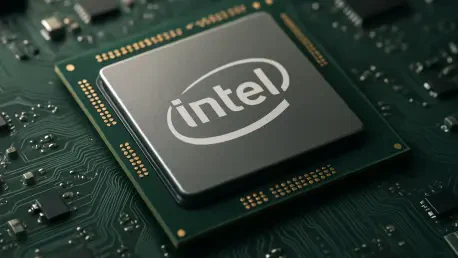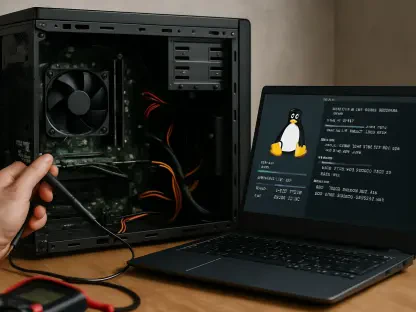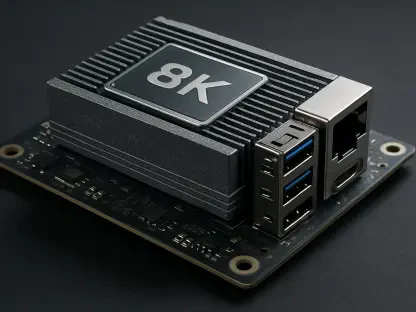Amid the high-stakes race for semiconductor supremacy, Intel, a cornerstone of American tech innovation, stands at a critical juncture with reports of potential federal intervention through a government stake. Picture a landscape where global supply chains teeter on the edge due to geopolitical tensions, and the United States struggles to reclaim its dominance in chip manufacturing. With billions in federal funding at play through initiatives like the CHIPS Act, and Intel’s ambitious Ohio facility facing significant delays, the question looms large: can government involvement steer Intel back to prominence, or will it deepen the complexities of an already challenged giant? This market analysis dives into the trends, data, and projections surrounding Intel’s struggles, exploring the implications of federal support and the broader impact on the U.S. semiconductor industry.
Market Landscape: Intel’s Position Amid Global Competition
The semiconductor market remains a fiercely competitive arena, with Intel grappling to maintain relevance against powerhouses like TSMC and Samsung. Current data indicates that TSMC holds a dominant share of advanced chip production, particularly in nodes below 7nm, while Intel lags with delays in rolling out its cutting-edge 14A technology. This gap has not only eroded Intel’s market position but also heightened U.S. concerns over reliance on foreign manufacturing, especially in Taiwan, amid escalating tensions with China. The push for domestic production has intensified, positioning Intel as a linchpin in national strategies to secure supply chains.
Beyond technological hurdles, Intel faces financial strain, with capital expenditure needs far exceeding available resources, even with subsidies from the CHIPS Act. The Ohio fabrication site, often referred to as Silicon Heartland, symbolizes both promise and challenge, with mass production timelines now pushed several years ahead. Market analysts note that this delay undermines confidence among investors and customers alike, raising doubts about Intel’s ability to compete as a leading foundry. These dynamics underscore a broader trend: the urgent need for strategic realignment in a sector where speed and innovation dictate survival.
A comparative look at global trends reveals that government-backed initiatives are not unique to the U.S. Countries like South Korea and the European Union are also funneling billions into domestic semiconductor capabilities, signaling a worldwide shift toward localized production. For Intel, this presents both an opportunity to leverage federal support and a risk of falling behind if execution falters. The market’s trajectory suggests that without significant intervention—whether public or private—Intel’s share could continue to shrink against more agile competitors.
Federal Intervention: Market Impacts and Projections
Financial Injection vs. Strategic Risks
Speculation around a federal stake in Intel, potentially up to 10%, has sparked intense debate within market circles. Such an investment could provide a critical lifeline, accelerating projects like Silicon Heartland and bolstering Intel’s foundry ambitions with much-needed capital. Projections suggest that short-term funding could stabilize Intel’s balance sheet, potentially increasing investor confidence and driving stock value upward by as much as 15% in the near term, based on historical reactions to government-backed initiatives in other sectors like aerospace.
However, the flip side reveals substantial risks to market dynamics. A government stake might introduce bureaucratic oversight, slowing decision-making in an industry where agility is paramount. Historical parallels, such as the automotive bailout in 2009, show mixed results—while financial stability was achieved, innovation often lagged due to imposed constraints. Analysts caution that permanent federal ownership could deter private investment and key customers wary of political influence, potentially impacting Intel’s long-term market competitiveness.
Market sentiment also hinges on the structure of any intervention. If framed as a repayable loan rather than equity ownership, the impact on Intel’s autonomy could be minimized, preserving its ability to pivot strategically. Current forecasts indicate that a balanced approach—combining federal support with clear exit terms—could position Intel to regain ground, provided operational execution improves. The challenge lies in ensuring that financial relief translates into tangible technological advancements rather than temporary respite.
National Priorities Shaping Industry Trends
The intersection of national security and market strategy forms a pivotal trend influencing Intel’s future. The U.S. government views domestic chip production as a non-negotiable priority, with policies aimed at reducing dependency on Asian supply chains gaining bipartisan support. This focus has driven significant allocations under the CHIPS Act, with Intel slated to receive billions to expand manufacturing capacity. Market analysis suggests this could catalyze a 20% increase in domestic semiconductor output over the next five years, with Intel at the forefront if delays are mitigated.
Yet, aligning national goals with corporate strategy poses inherent conflicts. Government involvement risks skewing Intel’s focus toward policy-driven projects rather than market-driven innovation, potentially alienating global clients like Apple or Nvidia who prioritize efficiency over geopolitics. Projections for the sector highlight a delicate balance: while federal backing could solidify Intel’s role in U.S. markets, it may strain partnerships abroad, where competitors operate without similar constraints. This tension could reshape market alliances and influence long-term growth trajectories.
An additional layer of complexity emerges in global perceptions. A federal stake might signal stability to some investors, reinforcing Intel’s strategic importance. Conversely, it could raise concerns among international stakeholders about political interference, impacting contract negotiations. Market forecasts emphasize that Intel must complement any government support with demonstrable product competitiveness to maintain its standing, as capital alone cannot bridge technological gaps. This dual challenge of national alignment and global relevance will define the company’s market path.
Future Outlook: Semiconductor Trends and Intel’s Trajectory
Looking ahead, the semiconductor industry is poised for transformative shifts, with Intel’s role hanging in the balance. Investment in domestic production is expected to surge, driven by legislative incentives and growing demand for chips in AI, automotive, and defense sectors. Market data projects a compound annual growth rate of 8% for U.S.-based manufacturing from the current year to 2027, with Intel potentially capturing a significant portion if it overcomes internal bottlenecks. Success in advanced process nodes remains a critical variable for regaining trust and market share.
Regulatory landscapes are also evolving, with potential trade policies prioritizing American-made chips likely to influence strategic planning. Such shifts could benefit Intel by creating protective barriers against foreign competitors, though they may also escalate costs for end-users, affecting demand dynamics. Analysts predict that technological innovation will ultimately determine winners in this space—Intel’s ability to deliver on delayed technologies like 14A could restore confidence, while failure to do so might cede further ground to rivals.
Emerging trends in consumer and industrial applications add another dimension. The rapid adoption of AI-driven technologies and electric vehicles is fueling unprecedented chip demand, creating openings for Intel to pivot toward specialized markets. Projections suggest that diversifying beyond traditional PC processors into these high-growth areas could offset current losses, provided the company aligns its R&D focus accordingly. The next few years will test whether Intel can harness these market currents alongside federal support to carve out a sustainable competitive edge.
Reflecting on Intel’s Market Challenges and Strategic Pathways
Looking back, the analysis of Intel’s position in the semiconductor market revealed a complex interplay of operational struggles, competitive pressures, and national imperatives. The potential federal stake emerged as a double-edged sword, offering financial relief but risking strategic autonomy. Market trends underscored the urgency of domestic production, while projections highlighted the critical need for technological breakthroughs to secure long-term viability. For stakeholders, the path forward demanded careful navigation of these dynamics to balance immediate needs with future growth.
Moving ahead, strategic recommendations centered on structured federal support—prioritizing temporary loans over permanent ownership to safeguard Intel’s independence. Leadership was urged to accelerate innovation, focusing on high-growth sectors like AI and automotive chips to diversify revenue streams. Businesses reliant on semiconductors were advised to monitor Intel’s progress while exploring alternative suppliers to mitigate risks. Policymakers needed to ensure that national goals complemented market realities, fostering an environment where Intel could thrive without undue interference. These actionable steps offered a blueprint for turning market challenges into opportunities for resurgence.









